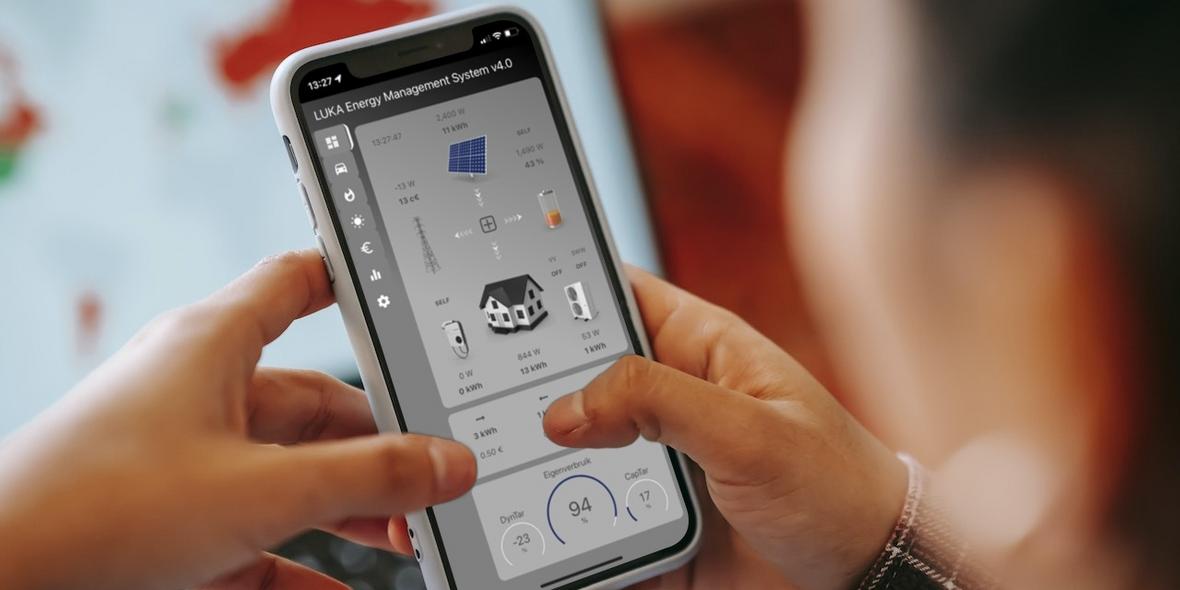28. Sep 2023
KNX Hackathon Winner: Increasing Self-consumption to 90% using KNX and the LUKA Energy Manager

Luc Vercruyssen explains how the consumption of self-generated power in a home can typically be increased to 90% using a KNX installation controlled by the LUKA Energy Manager, and that's before even further savings through dynamic tariffs are taken into account.
As the electrification of our homes and transport is happening at an unprecedented speed, the need for smart grids and smart buildings is becoming unavoidable. This is because in the drive to de-carbonise by transitioning from thermal or nuclear power plants to renewable energy sources, the variable nature of wind and solar energy can result in an imbalance between supply and demand. In times of energy shortage, gas plants are fired up causing enormous amount of CO2 emissions, whilst in times of renewable energy excess, wind and solar farms are shut down in order to avoid grid overload. If energy usage in buildings can optimised through intelligent systems, we can avoid a huge amount of energy from being wasted and reduce our carbon footprint.
Tangible savings

We can show that when using a PV system, annual energy costs can be reduced further by adding a home battery; then further still by using energy management to increase peak shaving; and yet more by using energy management to take full advantage of dynamic tariffs.
Using a KNX installation comprising a charging station, heat pump and home battery, all managed by the CDI-Projects LUKA Energy Manager, we showed that we could make total savings for an average household of around EUR1000 per year by:
- Increasing self-generated energy usage from 70% to 90%
- Decreasing peaks in grid usage by 100%
- Reducing the cost of grid energy usage by 30%
The advantages of KNX
LUKA connects to the KNX network via a KNX/IP router, and takes advantage of KNX switch actuators and KNX gateways in order to measure energy flows and to control technical installations such as EV chargers, PV arrays, heat pumps, home batteries and other appliances. It also uses web services such as weather forecasts and electricity tariffs to collect all of the information required to optimise energy flows.
Using KNX to communicate with smart home components ensures a future-proof, flexible and reliable system. Indeed, by using standard off-the-shelf KNX interfaces, no software development is necessary to control these devices.
Practical demonstration
We set up a practical KNX installation comprising a Mennekes charging station connected via the ise SMART CONNECT KNX e-charge II gateway; a Daikin heat pump connected via the Zennio KLIC-DA v2 gateway; an AlphaESS home battery connected via the ABB Modbus KNX Gateway; and the LUKA connected via the MDT IP Interface. We showed that significant savings could be made through increasing self-consumption, performing peak shaving, and balancing electricity production and demand by reacting to dynamic (time-of-use) electricity tariffs.
Savings and returns

Figure
1 - Simulation showing cost per year of using solar panels and the grid to
supply electricity for the home and car charging, with excess generation being
injected back into the grid.
The following is a simulation of a customer with an annual electricity consumption of 10000kWh. Using solar panels and the grid to supply the home with power, including car charging, the set-up results in 33% of the customer's energy needs being met by self-generation, with excess self-generated power being injected back into the grid, as shown in Figure1.

Figure
2 - Simulation showing total investment cost, cost per year of energy, and an
increase in self-consumption thanks to the addition of a home battery.
Next, the simulation shows that if a home-battery were installed, the self-consumption would increase from 33% to 70%, and the ROI would be 16.9 years, as shown in Figure 2.

Figure 3 - Simulation showing total investment cost, cost per year of energy, and an increase in self-consumption thanks to the further addition of the LUKA energy management.
By adding energy management system to manage the energy intelligently, self-consumption is increased to 90%, and the ROI is reduced to 13.1 years, as shown in Figure 3.

Figure 4 - Simulation showing that further savings can be made by using a time-of-use electricity tariff, at no extra cost.
Then, by changing to a time-of-use (ToU) electricity tariff, the annual cost reduces further still, and the ROI drops to 8.8 years, as shown in Figure 4. Note: the simulation of the electricity invoice is done using the ‘V-test’, which is an independent simulation tool.
Conclusion
Through simulations and practical installations that optimise self-generated energy, perform peak shaving, and make the best use of dynamic electricity tariffs, we have proved that a KNX-based energy management system can result in significant energy savings, resulting in reduced costs and carbon footprint. The return on investment is already good, and at scale, would increase even further.
Luc Vercruyssen is an industrial engineer and Director of CDI-Projects, a company specialising in energy management and smart buildings.
Highlights
-
 News
NewsYou can now apply for the KNX Awards 2024!
The KNX Awards is a long-standing competition that puts the smartest KNX home and building projects in the picture. Hand in ... -
 News
NewsThe KNX Journal 2024 is now available
The latest edition of our annual smart home and building solutions magazine has arrived. The KNX Journal 2024 offers ... -
 News
NewsBoost your business with the KNX Toolkit for Professionals
Are you a professional looking to bring your KNX business to the next level? KNX Association has just the thing for you – ...
